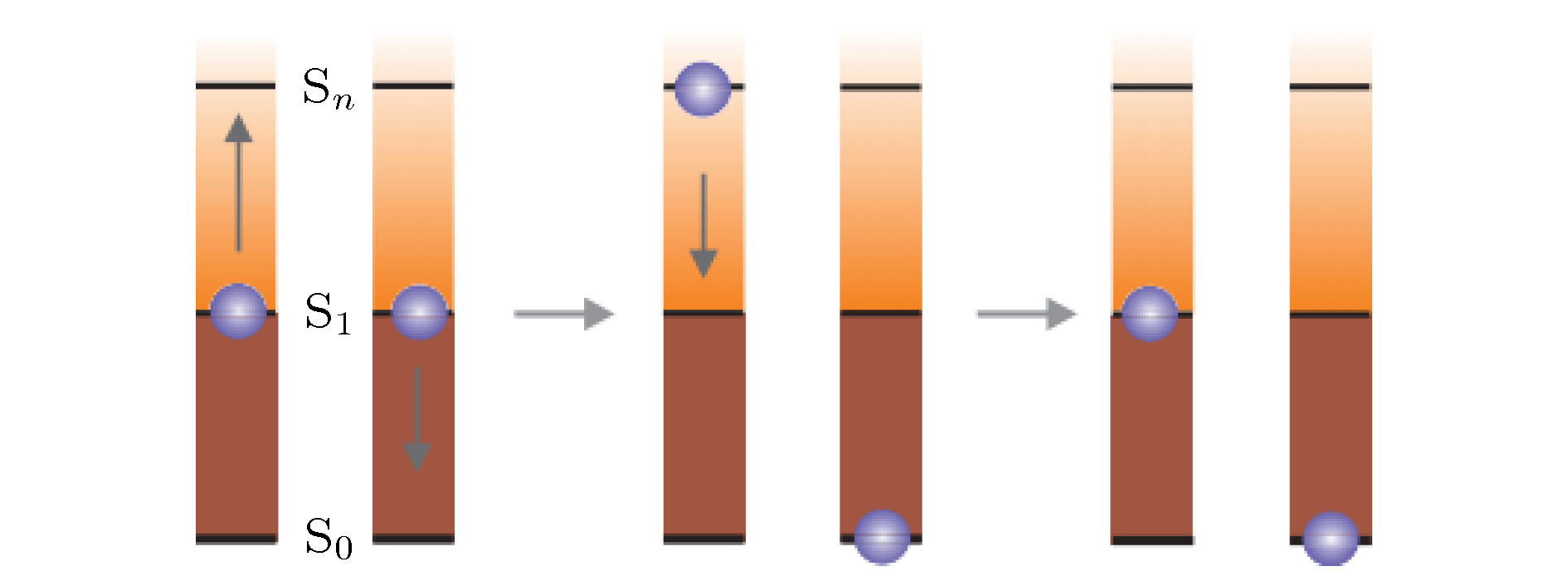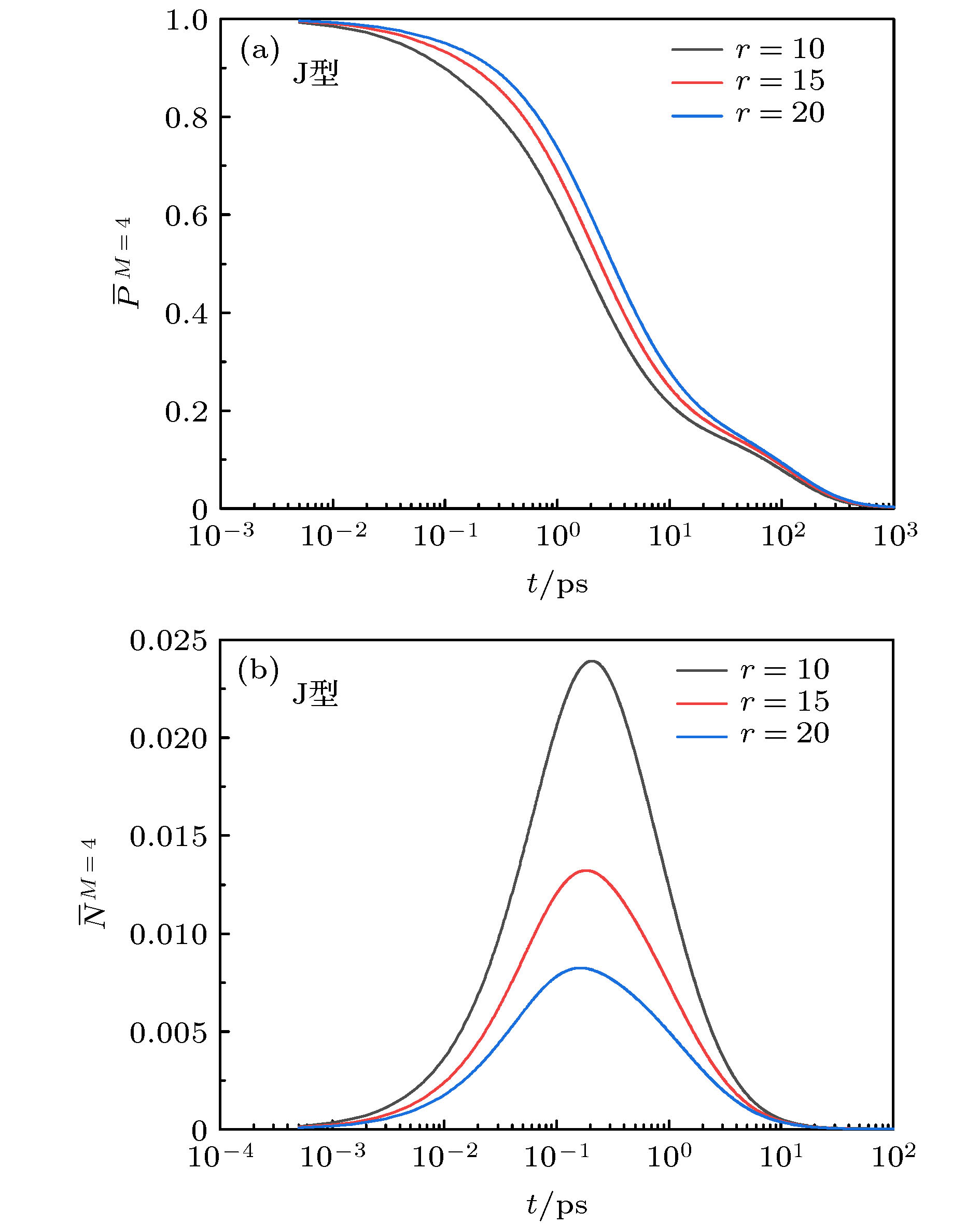-
It is of ongoing interest to uncover energy and charge transfer processes in molecular systems, which are essentially important for photovoltaic cells or light emitting diodes. The exciton-exciton annihilation is one of the important aspects in excitation energy transfer in molecular aggregations, so it is important to study its dynamics of exciton-exciton annihilation, and to compare the theoretical parameters with the related transient absorption signal. Upon the excitation of laser pulses, multiple excitons can be produced in molecular aggregations, and its annihilation process is composed of two steps. The first step is that two excitations existing in the first excited state of the molecules move together so that their excitation energy can be used to create a high excited state in one molecule, called exciton fussion. The second step is that an ultrafast internal conversion process brings the molecule which is in the higher excited state back to the first excited state. This paper uses the scheme of classical rate equation in the approximation of weak coupling among molecules to describe the dynamics of exciton-exciton annihilation. With the parameters of squaraine, the effects of external or internal parameters such as the intensity of external field, the dipole configuration in aggregations, the decay rate of molecules on the annihilation process are studied. The relationship between the relaxation time of exciton in the first excited state and the high excited state, between their times of coherent charge transfer, and between their times of exciton and annihilation are studied. These conclusions are suitable to the aggregations with their single molecule having an energy level of
${E_{\rm fm}} \approx 2{E_{\rm em}}$ . It is found that the J-aggregate has a higher rate of annihilation than the H-aggregate because its coherent energy transfer time is shorter than H-aggregate’s. The high-intensity external field makes high exciton-exciton annihilation rate. The dipole configuration and the decay rate of higher excited state of molecules have strong effects on the annihilation, so one can adjust these factors to control the exciton-exciton annihilation in molecular aggregations.-
Keywords:
- exciton-exciton annihilation /
- rate equation /
- singlet state annihilation /
- excitation of femtosecond laser pulse
[1] Knox R S 1963 Theory of Excitons, Solid State Physics, Adv. in Research and Applications (New York: Academic Press) pp1−15
[2] Davydov A S 1971 Theory of Molecular Excitons (New York: Plenum Press) pp1−21
[3] Savoie M B, Jackson N E, Chen X L, Marks J T, Ratner A M 2014 Acc. Chem. Res. 47 3385
 Google Scholar
Google Scholar
[4] Spano C F, Silva C 2014 Annu. Rev. Phys. Chem. 65 477
 Google Scholar
Google Scholar
[5] Tamai Y, Ohkita H, Benten H, Ito S 2015 J. Phys. Chem. Lett. 6 3417
 Google Scholar
Google Scholar
[6] Reineke S, Thomschke M, Lüssem B, Leo K 2013 Rev. Mod. Phys. 85 1245
 Google Scholar
Google Scholar
[7] Brédas L J, Beljonne D, Coropceanu V, Cornil J 2004 Chem. Rev. 104 4971
 Google Scholar
Google Scholar
[8] Wasielewski R M 2009 Acc. Chem. Res. 42 1910
 Google Scholar
Google Scholar
[9] Hader K, May V, Lambert C, Engel V 2016 PCCP 18 13368
 Google Scholar
Google Scholar
[10] Odom T W, Schatz G C 2011 Chem. Rev. 11 3667
[11] Feist J, Garcia-Vidal F J 2015 Phys. Rev. Lett. 114 196402
 Google Scholar
Google Scholar
[12] Schachenmayer J, Genes C, Tignone E, Pupillo G 2015 Phys. Rev. Lett. 114 196403
 Google Scholar
Google Scholar
[13] Han D, Du J, Kobayashi T, Miyatake T, Tamiaki H, Li Y 2015 J. Phys. Chem. B 119 12265
 Google Scholar
Google Scholar
[14] Ma F 2018 J. Phys. Chem. B 122 10746
 Google Scholar
Google Scholar
[15] Wang L, May V 2016 Phys. Rev. B 94 195413
 Google Scholar
Google Scholar
[16] May V 2014 J. Chem. Phys. 140 054103
 Google Scholar
Google Scholar
[17] Wang L, Plehn T, May V 2020 Phys. Rev. B 102 075401
 Google Scholar
Google Scholar
[18] Tempelaar R, Jansen T L C, Knoester J 2017 J. Phys. Chem. Lett. 8 6113
 Google Scholar
Google Scholar
[19] May V, Kühn O 2011 Charge and Energy Transfer Dynamics in Molecular Systems (Weinheim: Wiley-VCH) pp12−22
[20] Völker S F, Schmiedel A, Holzapfel M, Renziehausen K, Engel V, Lambert C 2014 J. Phys. Chem. C 31 17467
-
图 1 激子-激子湮灭过程的能级示意图. 能级结构分别为基态(
${{\rm{S}}_0}$ )、第一激发态(${{\rm{S}}_1}$ )和高阶激发态(${{\rm{S}}_n}$ ), 蓝色小球表示激发电子. 左图: 两个分子都处于第一激发态; 中图: 激子融合, 右边分子回到基态, 左边分子至高阶激发态; 右图: 左边分子回到第一激发态的内转换过程[16]Figure 1. Energy level diagram of exciton-exciton annihilation. Shown are the ground state (
${{\rm{S}}_0}$ ), the first excited state (${{\rm{S}}_1}$ ) and the higher order excited state (${{\rm{S}}_n}$ ) of a pair of molecules. The blue balls represent excited electrons. Left panel: Both molecules are in their first excited state; Middle panel: Exciton fusion, the right molecule returns to the ground state, and the left molecule goes to a higher excited state; Right panel: The internal conversion process of the left molecule back to the first excited state[16].图 5 J型与H型分子聚集体的激子-激子湮灭率随分子数变化曲线. (a)
$P(0) = \displaystyle\sum\nolimits_m {{P_m}} (0){{ = 6}}$ 时J型与H型湮灭率曲线; (b)$P(0){{ = 6}}$ 时J型与H型湮灭率的比值; (c) 不同$P(0)$ 下J型湮灭率曲线Figure 5. The curve of exciton-exciton annihilation rate of J-type and H-type molecular aggregates with the number of molecules. (a) J-type and H-type annihilation rate curve when
$P(0) = \displaystyle\sum\nolimits_m {{P_m}} (0){{ = 6}}$ ; (b) The ratio of J-type and H-type annihilation rate when$P(0){{ = 6}}$ ; (c) J-type annihilation rate curve under different$P(0)$ .表 1 率方程的输入参数
Table 1. Input parameters of the rate equation.
${\rm{Rate} }/{\rm{p} }{ {\rm{s} }^{ - 1} }$ ${\rm{Lifetime} }/{\rm{ps} }$ k ${10^{ - 3}}$ $1000$ r $10-20$ $0.1-0.05$ $\gamma _{mn}^{\rm{J}}$ $1.3 \times {10^{ - 2}}$ $76.9$ $\gamma _{mn}^{\rm{H}}$ $3.37 \times {10^{ - 3}}$ $296.7$ $\varUpsilon _{mn}^{\rm{J}}$ $2.98$ $0.33$ $\varUpsilon _{mn}^{\rm{H}}$ $7.44 \times {10^{ - 1}}$ $1.33$ -
[1] Knox R S 1963 Theory of Excitons, Solid State Physics, Adv. in Research and Applications (New York: Academic Press) pp1−15
[2] Davydov A S 1971 Theory of Molecular Excitons (New York: Plenum Press) pp1−21
[3] Savoie M B, Jackson N E, Chen X L, Marks J T, Ratner A M 2014 Acc. Chem. Res. 47 3385
 Google Scholar
Google Scholar
[4] Spano C F, Silva C 2014 Annu. Rev. Phys. Chem. 65 477
 Google Scholar
Google Scholar
[5] Tamai Y, Ohkita H, Benten H, Ito S 2015 J. Phys. Chem. Lett. 6 3417
 Google Scholar
Google Scholar
[6] Reineke S, Thomschke M, Lüssem B, Leo K 2013 Rev. Mod. Phys. 85 1245
 Google Scholar
Google Scholar
[7] Brédas L J, Beljonne D, Coropceanu V, Cornil J 2004 Chem. Rev. 104 4971
 Google Scholar
Google Scholar
[8] Wasielewski R M 2009 Acc. Chem. Res. 42 1910
 Google Scholar
Google Scholar
[9] Hader K, May V, Lambert C, Engel V 2016 PCCP 18 13368
 Google Scholar
Google Scholar
[10] Odom T W, Schatz G C 2011 Chem. Rev. 11 3667
[11] Feist J, Garcia-Vidal F J 2015 Phys. Rev. Lett. 114 196402
 Google Scholar
Google Scholar
[12] Schachenmayer J, Genes C, Tignone E, Pupillo G 2015 Phys. Rev. Lett. 114 196403
 Google Scholar
Google Scholar
[13] Han D, Du J, Kobayashi T, Miyatake T, Tamiaki H, Li Y 2015 J. Phys. Chem. B 119 12265
 Google Scholar
Google Scholar
[14] Ma F 2018 J. Phys. Chem. B 122 10746
 Google Scholar
Google Scholar
[15] Wang L, May V 2016 Phys. Rev. B 94 195413
 Google Scholar
Google Scholar
[16] May V 2014 J. Chem. Phys. 140 054103
 Google Scholar
Google Scholar
[17] Wang L, Plehn T, May V 2020 Phys. Rev. B 102 075401
 Google Scholar
Google Scholar
[18] Tempelaar R, Jansen T L C, Knoester J 2017 J. Phys. Chem. Lett. 8 6113
 Google Scholar
Google Scholar
[19] May V, Kühn O 2011 Charge and Energy Transfer Dynamics in Molecular Systems (Weinheim: Wiley-VCH) pp12−22
[20] Völker S F, Schmiedel A, Holzapfel M, Renziehausen K, Engel V, Lambert C 2014 J. Phys. Chem. C 31 17467
Catalog
Metrics
- Abstract views: 15687
- PDF Downloads: 274
- Cited By: 0






















 DownLoad:
DownLoad:












